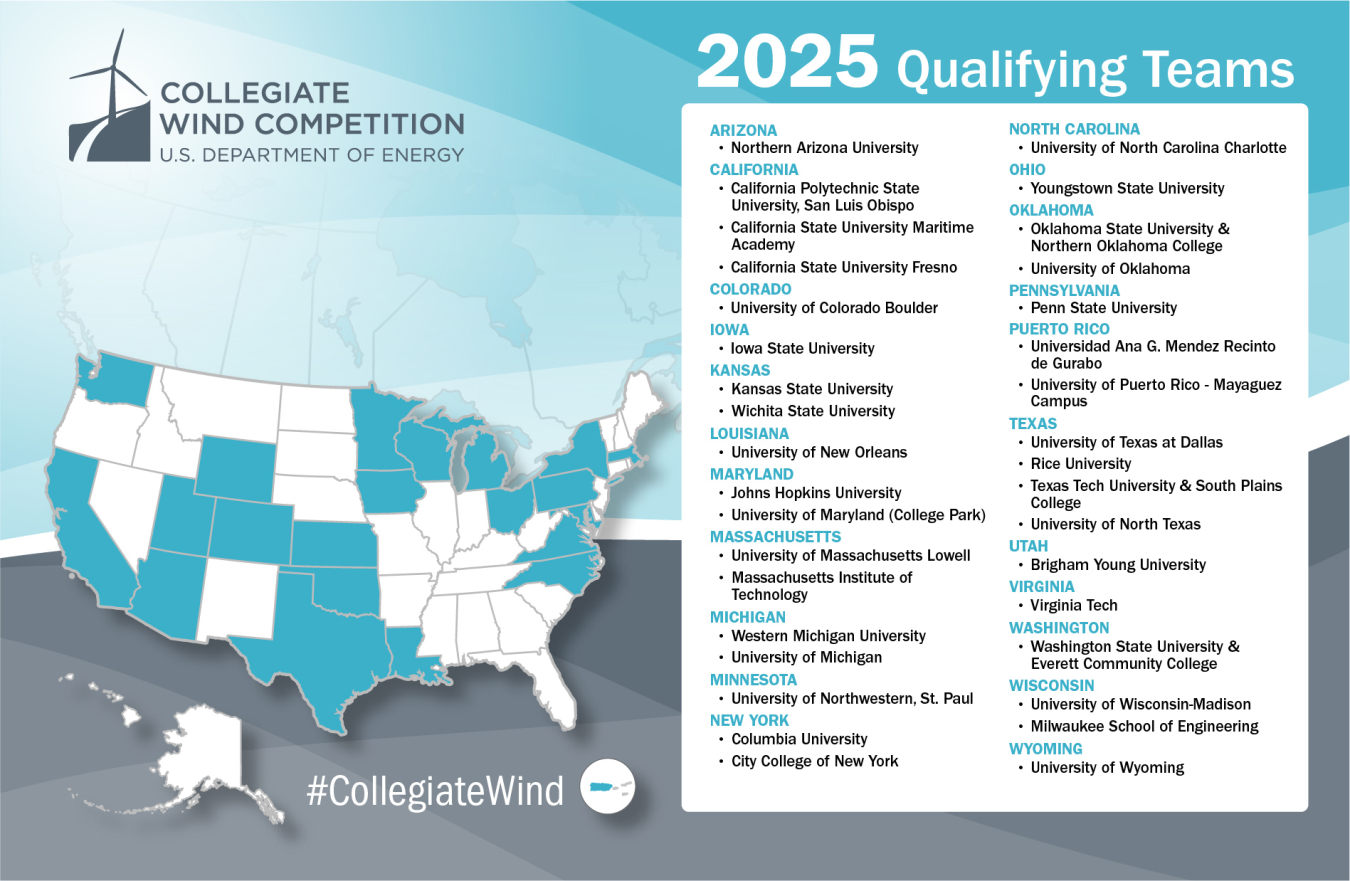During the first half of the 2024–2025 school year, 35 teams will participate in the 2025 Collegiate Wind Competition to design floating offshore wind energy technology.
September 11, 2024Today, the U.S. Department of Energy (DOE) announced the 35 college and university teams that have qualified to participate in the 2025 Collegiate Wind Competition (CWC) during the first half of the 2024–2025 school year.
A strong wind industry workforce and supply chain will be essential to reaching the nation’s climate goals and are vital to the future success of the wind energy industry. Since 2014, the CWC has helped prepare that future workforce by inviting college students from a range of disciplines to represent their schools as they design, build, and test a model wind turbine; develop a site plan and cost-of-energy analysis for a hypothetical wind farm; and conduct outreach to the wind energy industry, their communities, and local media outlets.
The 2025 CWC will focus on the siting, outreach, and development challenges associated with floating offshore wind energy projects. During the first half of the upcoming school year (September 2024–January 2025), teams will develop a preliminary design and report for their model wind turbine and a preliminary site design for their hypothetical floating offshore wind farm. The teams will also create an outreach strategy, which may include, for example, interviewing professionals from different wind industry sectors to learn about career opportunities and/or developing outreach materials to educate and inspire younger students.
Each qualifying team will receive $2,000 in funding, which they can use to begin designing their prototype wind turbine, creating their wind energy project development plans, and conducting their outreach activities.
The college and university teams that have qualified to participate in the 2025 Collegiate Wind Competition are:
- Brigham Young University
- California Polytechnic State University
- California State University Maritime Academy
- California State University, Fresno
- Columbia University (Columbia University in the City of New York)
- Iowa State University
- Johns Hopkins University
- Kansas State University
- Massachusetts Institute of Technology
- Milwaukee School of Engineering
- Northern Arizona University
- Oklahoma State University (with Northern Oklahoma College)
- Rice University
- Texas Tech University (with South Plains College)
- The City College of New York
- The Pennsylvania State University
- Universidad Ana G. Méndez Recinto de Gurabo
- University of Colorado Boulder
- University of Maryland
- University of Massachusetts Lowell
- University of Michigan
- University of New Orleans
- University of North Carolina at Charlotte
- University of North Texas
- University of Northwestern – St. Paul
- University of Oklahoma
- University of Puerto Rico at Mayagüez
- University of Texas at Dallas
- University of Wisconsin-Madison
- University of Wyoming
- Virginia Tech
- Washington State University Everett (with Everett Community College)
- Western Michigan University (with Kalamazoo College)
- Wichita State University
- Youngstown State University

By early 2025, the competition organizers will use a performance-based selection process to narrow the competition to, at most, 12 final teams. These finalist teams will be invited to continue participating in the CWC during the second half of the school year (January 2025–May 2025) and will be awarded an additional $15,000 to complete their projects, which includes building their prototype wind turbines. The finalist teams will also be invited to test their model turbines in an on-site wind tunnel and present their work at the CWC final event, where they will be eligible for prize funding from a $30,000 prize pool.
The CWC is funded by DOE's Wind Energy Technologies Office and managed by the National Renewable Energy Laboratory.
Sign up for email alerts to never miss a CWC update. To find more opportunities for students to gain renewable energy experience while still in school, visit the DOE Office of Energy Efficiency and Renewable Energy's Student Competitions and Prizes page. For updates on DOE's Wind Energy Technologies Office activities, subscribe to the Catch the Wind newsletter.

